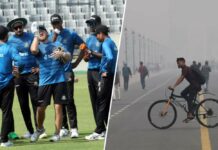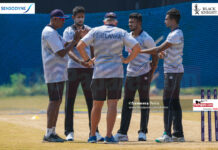Over the last eight years, Sri Lanka have established themselves as the most consistent side in International Cricket Council events. Success was elusive until the World Twenty20 in Bangladesh in 2014, but since making the final of the World Cup in the West Indies in 2007, Sri Lanka have been involved in title clashes more often than any other team.
They made the final of the World T20 in England in 2009, going down to Pakistan, and were well beaten by an inspired India in the 2011 World Cup title round in Mumbai. Their most disappointing result was defeat to West Indies in their own backyard, at the R Premadasa Stadium in Colombo, in the final of the 2012 World T20. The Mirpur triumph, under Lasith Malinga, in the final Twenty20 International for both Mahela Jayawardene and Kumar Sangakkara, came as a massive relief, as much as anything else, for a team that had somehow fallen short at the final hurdle.
However, the fact that Sri Lanka have made so many finals is alone indicative of the quality within their ranks, and their ability to remain grounded in the big tournaments. For the fourth straight time since 2003, Sri Lanka have made it to the knockout stage of the World Cup; against them in Wednesday’s (March 18) first quarterfinal of the 2015 World Cup are South Africa, a team that for all its supreme skills has somehow managed to court disaster in the tournaments that matter.
Marvan Atapattu, Sri Lanka’s coach, is a canny old fox. He fired the first psychological salvo on Sunday, reflecting on Sri Lanka’s better record in knockout stages than South Africa’s. “That’s something that will work in their minds,” said Atapattu, a former Sri Lankan captain. “We would like to take this game as a fresh game for us. We’d like to start from scratch and build up confidence as the game progresses, in whatever we do – bat or bowl first. More importantly, we’ve got to be able to absorb pressure, be calm and go about doing our roles to the best that we can.
“We’ve got a lot of experience. If you count the number of matches all of us have had, within the 15, it’s more than any other team in the competition. So for them, having been so long in the system and played so many World Cup and knockout games, they know how to cope with pressure, and they know exactly how to prepare for that. The advice to the team is to keep doing the good things that have brought us to this stage. We (the coaching staff) are working on lifting the team in terms of confidence and keeping the team together.”
In Jayawardene, Sangakkara, Tillakaratne Dilshan and Lasith Malinga, Sri Lanka have a wealth of big-match expertise. “I’ve been with these players for four years now, and we’ve come to so many big tournament matches where we have had to win,” said Atapattu. “I’ve seen people raise their game, and I’ve seen people raise the whole team. I see no difference this time, and because I’ve seen that, I have confidence in these guys doing it again. When it comes to working together, pulling things together and working towards a common goal, we’re among the best.”
After an understandably rusty start to the World Cup considering that he was playing international cricket after nearly six months, Malinga has cranked up the speed and gradually worked towards somewhere near his best. Atapattu acknowledged Malinga’s noticeable progress as the World Cup has gone on, expecting big things of his bowling spearhead. “He feels confident, which is the most important thing,” he observed. “You may not see the same speed that he got two or three years back, but that’s something that everybody, including the greats, have had to face. Lasith is somebody who, come the big game, can rise to that. He’s somebody that is looking forward to having a good performance. He’s a match-winner, and I’m sure he’ll live up to that.”
In saying that, Sri Lanka’s bowling has been a little below par, particularly with Rangana Herath missing the last few games after splitting the webbing in his bowling hand. With the stitches removed, Herath is back in business, gingerly feeling his way back. “Today’s his first day in the nets after he had his stitches removed. He’ll be getting into bowling and seeing how comfortable he is with the ball. We’ll try that out today and see how he goes. These are not the easiest of conditions to bowl in, as you may have seen with all the other attacks,” said Atapattu as he sought to explain Sri Lanka’s bowling travails.
“With restrictions on field placings, it’s always a challenge. In a competition like this where cricket is looking to have a step up, you see bowlers come under a lot more pressure than in a normal tournament.”
Sri Lanka’s batting, however, has been firing on all cylinders, Sangakkara leading the way with four straight tons. “We all knew what we were capable of when it came to batting. It’s just a matter of clicking and winning at the right time. Big games bring out the best of big players,” emphasised Atapattu. “Then we start to see some of the others also chipping in with useful scores, getting the runs that we required at different times.
“When you have four guys out of seven firing, that tells a story. You can’t have all seven guys firing. In different competitions, people get into form and it’s their responsibility to take the team to big scores, and to ensure the chases are being done successfully. That has been happening, and that’s always a good side. We would like to have everybody scoring and being in a good frame of mind. I think everybody is. It’s unfortunate to lose a player like Chandi (Dinesh Chandimal) in the middle of the tournament. But we have more than a few experienced guys, with Upul (Tharanga) and Kusal (Perera) coming into the middle order.”
Kusal is essentially an opening batsman, but has been thrust into the middle order after a hamstring injury ended Chandimal’s tournament, by which time Lahiru Thirimanne had reasonably established himself as Dilshan’s opening partner. “I always believe that if you’re good enough, you should be able to bat anywhere from No. 1 to 7 without a problem. Given the other batsmen and what’s required for the team, it might be the case that he has to bat lower,” said Atapattu of Kusal. “If he is a good enough batsman – which I think he is – he’ll adapt to that and do that job successfully.”
Before the World Cup, Sri Lanka travelled to New Zealand for two Tests and seven One-Day Internationals. They lost the two-Test series 0-2 and were beaten 2-4 in the ODIs, but Atapattu disagreed with suggestions that his team had played badly, even as he spoke of the discussions within the team at the end of the tour. “First of all, we didn’t do badly in New Zealand. It was only one Test match in which we were outplayed. We almost won the second one. It was a missed catch that cost us the whole game, otherwise we would have finished that Test within three days,” he insisted. “We lost the ODI series 4-2, where we all believe we could have won at least one more. This is against New Zealand, who on paper and in performance have been the best side up until now. So it’s not a bad performance for us.”























